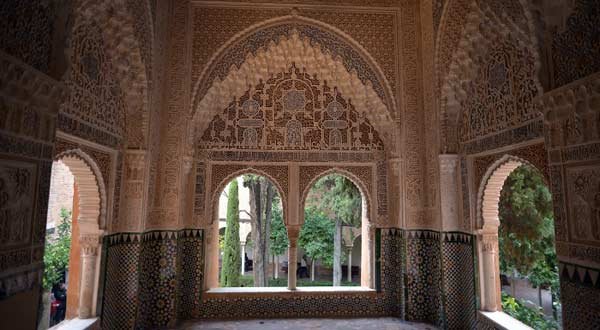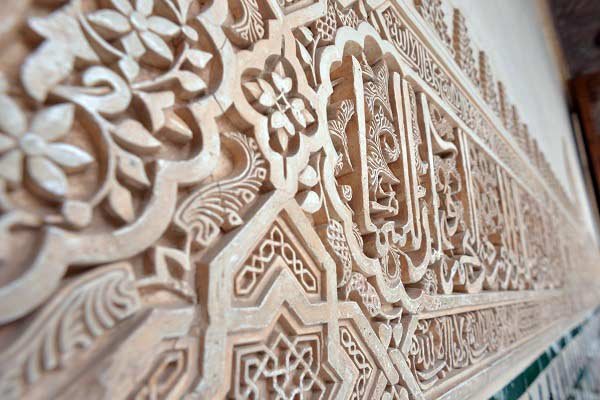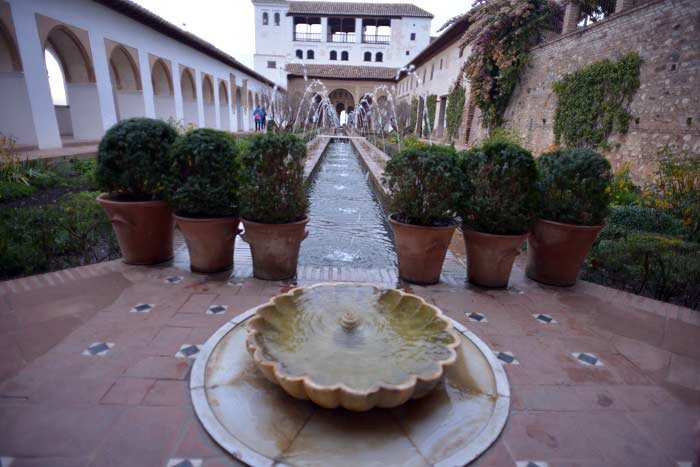

A long dreamed journey to Spain and Granada, the lost citadel of the great Islamic civilization in Europe, finally takes shape. Granada is home to Al Hambra Palace and the magnificent Generalife Gardens, two jewels of Islamic architecture that find a place in UNESCO’s World Heritage sites
RABIA ALAVI
[dropcap]I[/dropcap]T was raining cats and dogs when we reached our hotel in Granada. Located at the foot of the Sierra Nevada Mountains, (where heavy snowfall was predicted for the night), the city was also extremely frosty. We settled in our luggage, adding an extra layer of clothing to the already existing ones before setting out.
Barcelona had been teeming with history and culture too, but it is the Andalusian region — laden with some of the most famous vestiges of Arab Spain that had actually brought us here.
With pre-bought tickets, we headed off to see Al Hambra Palace and the magnificent Generalife gardens, two jewels of Islamic architecture that find a place in UNESCO’s World Heritage sites.
The Al Hambra complex stands majestically on the Asabica hills in the north of the city. It took 170 years to complete, as successive rulers of the Nasrid dynasty gave it add-ons of their own.
Starting off as a citadel, to ward off Christian incursions from the North, the Palace was added by the first ruler of the Nasrid dynasty – to serve as the royal residence. Later rulers added more watchtowers, and a beautiful mosque to the complex. After the fall of Granada, the mosque was unfortunately destroyed and a church built in it place.
In fact, after the fall of Granada to Christians, the complex was both vandalized and neglected for centuries. Restoration began just a hundred years ago, when scholars and travellers stressed the importance of preserving Al Hambra’s glory.

The Al Hambra complex stunned me; I could not help but wonder what inspiration and engineering went into creating this masterpiece. Often embellished with verses from the Holy Quran, I moved across Palace buildings, walking past a myriad of enticing marble colonnades, arches and stuccoed domes.
I stopped to admire a lush green courtyard lined with orange trees, with a fountain running in the center, only to find an even more beautiful one in the next. Called the Patio of the Lions, this courtyard was part of the private palace of the kings, where the Harem was located. And no, contrary to general belief, the Harem is not the place where the king kept his women cooped up and hidden from the rest of the world. It is just a residence – adorned and decorated to accommodate a king’s family.
This part of the Palaces is well restored, and solid wooden doors stand intact, as does a most perfect dome of mocárabes, an Arab form of decoration. The most famous fountain of the complex is also found in the center of this courtyard, a basin held up by a circle of 12 lions that throw in jets of water.

The Generalife Gardens are adjacent to the Palace buildings. A masterpiece of horticulture, they were structured to provide a place to rest and relax for the Nasrid rulers. Said to have undergone several alterations since they were first built, the gardens maintain their splendor.
There were roses in full bloom in the flowerbeds running across the length of the gardens. Carefully-trimmed green shrubs such as willow and cypress, and pine hedges form a uniform pattern, and an intricate network of canals and aqueducts streams for about eight kilometers to bring water up from the Daro River for the incessant supply of water needed to run the fountains, and keep the gardens in bloom.
For anyone familiar with Islam, this, then, was the result of someone’s painstaking effort to replicate Paradise, as it was described in the Holy Quran.
Within the Al Hambra complex is also found the Charles V Palace, built for the Holy Roman Emperor, Charles V, who wanted a permanent residence for his family inside the Al Hambra complex.
On its own, the palace is worth seeing, boasting an architecture that has no precedent, using a unique combination of square and circle – in the staircases, rooma and the patio, which is beautifully curved.
But after the magnificent Nasrid Palaces, this one failed to form much of an impression, even though it is said to be the most important building of Renaissance style in Spain. Also, many parts of the Nasrid Palaces had to be destroyed to make way for, what seemed to me, an unnecessary, intrusive structure.
Nonetheless, the charm and sophistication of Al Hambra complex (and the gentle, caressing hum of running water from its canals, so carefully built under balusters of stairs in the Generalife gardens) has stayed with me. It was once the kind of place that could fill only my dreams and imagination. Now I know that such splendor exists.
After spending what were a beautiful – though cold – two days in Granada, exploring the old areas of the city, which continue to exhibit an Arab influence in their architecture, cobbled streets and narrow bazaars — and also some of the newer ones, we took a fast-speed train to take us to our next destination – Córdoba.
